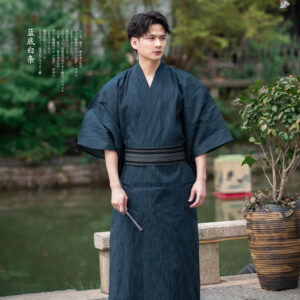
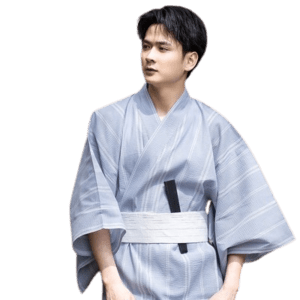
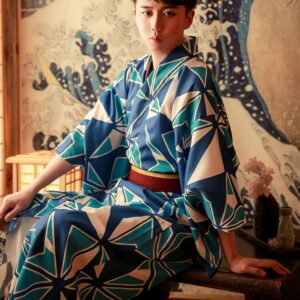
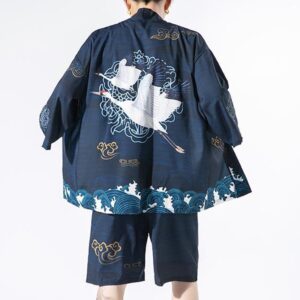
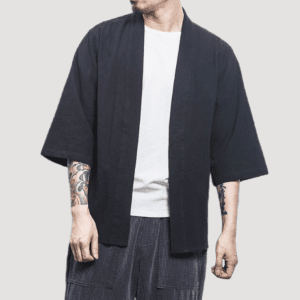
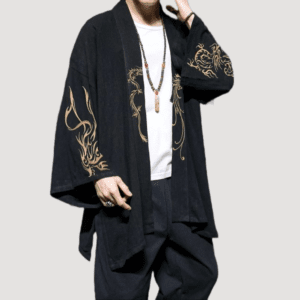
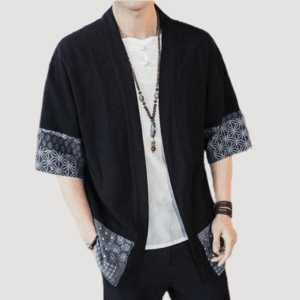

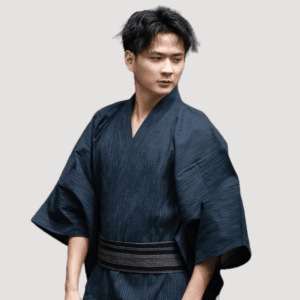
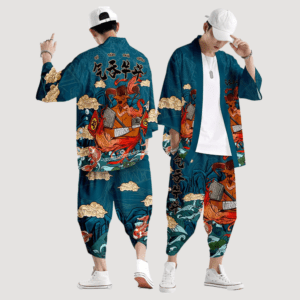
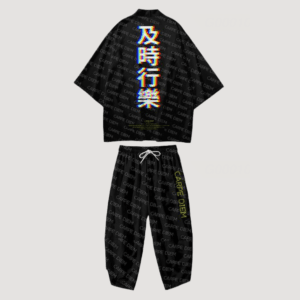
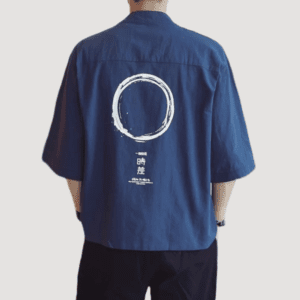
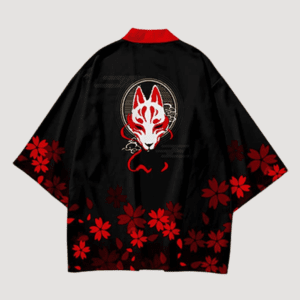
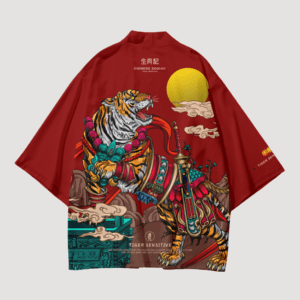
The Japanese kimono is a traditional garment that has a rich and fascinating history. It is believed to have originated in Japan over 1,300 years ago and has evolved over time to become the iconic garment it is today.
The word “kimono” literally means “something to wear,” and it was originally worn by people of all classes and genders in Japan. The first kimonos were simple garments made of hemp or linen, and they were worn by both men and women. Over time, the kimono became more elaborate and was made of luxurious fabrics such as silk.
During the Edo period (1603-1868), the kimono became a symbol of social status in Japan. The style and quality of a person’s kimono were used to indicate their wealth and position in society. The kimono also became a way for women to express their personal style and beauty, and it was common for women to own several different kimonos for different occasions.
In the 20th century, the kimono began to decline in popularity as Western clothing became more prevalent in Japan. However, it has experienced a resurgence in recent years as a symbol of Japanese culture and tradition. Today, the kimono is worn on special occasions such as weddings and festivals, and it is also worn by some people as a daily garment.
The Japanese kimono is a beautiful and unique garment that has a rich history and cultural significance. It is a symbol of Japan’s cultural heritage and is a testament to the country’s rich history of craftsmanship and artistry.
Japanese kimonos are known for their intricate and beautiful patterns, which are an integral part of the garment’s design and symbolism. There are many different types of patterns that can be found on a kimono, each with its own unique meaning and cultural significance.
One of the most iconic patterns on a kimono is the “crest” or “mon,” which is a graphic symbol that represents a family or a clan. The mon is typically found on the back of the kimono and is used to identify the wearer’s family or social status.
Another common pattern on a kimono is the “waving lines” or “shippou-tsunagi” pattern, which represents the bonds of friendship and unity. This pattern is often seen on kimonos that are worn on special occasions such as weddings and festivals.
Floral patterns are also a popular choice on kimonos, and each flower has its own meaning and symbolism. For example, the plum blossom represents perseverance and courage, while the cherry blossom represents the fleeting nature of life and beauty.
Other common patterns on a kimono include geometric shapes, animals, and nature scenes. These patterns can be symbolic of a variety of things, such as prosperity, good fortune, and the changing seasons.
The patterns on a Japanese kimono are a reflection of the wearer’s personality, cultural background, and style. Whether you prefer bold and bright patterns or more subtle and understated designs, there is a kimono pattern that is perfect for you.
In Japan, the kimono is much more than just a garment – it is a symbol of culture, tradition, and social status. Wearing a kimono is a meaningful and special occasion, and it is often reserved for special events such as weddings, festivals, and other formal occasions.
The kimono is traditionally worn by both men and women in Japan, although there are different styles and patterns for each gender. The kimono is a full-length garment that is worn wrapped around the body, with the left side overlapping the right. It is secured with a sash called an obi, which is tied in a specific pattern depending on the occasion and the style of kimono.
In Japanese culture, the kimono is a symbol of respect and humility. It is considered a formal garment and is often worn with other traditional accessories such as zori (sandals), geta (wooden sandals), and a haori (jacket). The kimono is also a way for people to express their personal style and taste, and it is common for people to own several different kimonos for different occasions.
The kimono is a significant part of Japanese culture and has a rich history that dates back over 1,300 years. It is a testament to Japan’s tradition of craftsmanship and artistry, and it is a beloved and enduring symbol of Japanese culture.
Japanese kimonos are beautiful and traditional garments that have been worn by Japanese people for centuries. If you’re interested in learning how to wear a kimono, there are a few steps you’ll need to follow.
First, lay the kimono out on a flat surface. The left side should be closest to you, and the bottom should be facing away from you. Next, wrap the left side of the kimono around your body, making sure that the bottom hem falls just above your ankles. Then, tie the obi (the sash) around your waist, pulling it tight to secure the kimono in place.
It’s important to note that there are different styles of kimonos for different occasions and for men, women, and children. For example, a formal kimono for a woman might have longer sleeves and a more intricate pattern, while a kimono for a man might be simpler and have shorter sleeves. Make sure to choose the appropriate style for the occasion.
Once you have the kimono properly draped around your body, it’s time to add the undergarments. The juban (undershirt) is worn underneath the kimono and should be visible at the neckline and sleeves. The nagajuban (under-kimono) is worn over the juban and should be long enough to cover the entire kimono, so that it is not visible when you wear the kimono.
After you have the undergarments in place, put your arms through the sleeves of the kimono and tie it closed with the himo (ties). The himo should be tied in a specific pattern, depending on the style of kimono you are wearing.
Finally, add any additional accessories such as a haori (jacket), obijime (sash tie), and obiage (sash wrapper) to complete the look. These items can help to add a touch of elegance and personal style to your kimono outfit. With a little practice and some guidance, you’ll be able to wear a kimono with confidence and grace.
Japanese kimonos are known for their intricate and beautiful designs, which are a testament to the country’s rich tradition of craftsmanship and artistry. The process of creating a kimono is a long and labor-intensive one, and it requires a great deal of skill and attention to detail.
The first step in creating a kimono is to design the pattern. This is typically done by hand using ink and brush, and the process can take several days or even weeks to complete. Once the pattern has been finalized, it is printed onto the fabric using a traditional woodblock printing method.
Next, the fabric is cut and sewn together to create the basic shape of the kimono. The kimono is then lined with a secondary fabric to give it added structure and support. The obi (sash) is also created at this stage, using a separate piece of fabric that is carefully matched to the kimono.
After the kimono has been constructed, it is time to add the finishing touches. This can include hand-sewn details such as embroidery, beadwork, and other embellishments. The kimono is then carefully pressed and inspected to ensure that it is of the highest quality.
Creating a Japanese kimono is a true labor of love, and it requires a great deal of skill and dedication. The end result is a beautiful and timeless garment that is a true work of art.
The Edo period (1603-1868) was a time of great cultural and social change in Japan, and it had a significant influence on the development of the Japanese kimono. During this time, the kimono became a symbol of social status and was used to indicate a person’s wealth and position in society.
One of the main ways that the Edo period influenced the kimono was through the development of new styles and patterns. The kimono became more elaborate during this time, with longer sleeves and more intricate patterns. These patterns were often inspired by nature, and they were used to convey specific messages or symbolism. For example, a kimono with a cherry blossom pattern might symbolize the fleeting nature of beauty, while a kimono with a geometric pattern might symbolize prosperity.
In addition to the development of new styles, the Edo period also saw the rise of the kimono as a fashion item. During this time, it became common for people to own several different kimonos for different occasions, and the kimono became a way for people to express their personal style and taste.
Overall, the Edo period had a significant impact on the development of the Japanese kimono and its cultural significance. It is a testament to the enduring influence of this period on Japanese culture and society.
The Japanese kimono is a garment that seamlessly blends tradition and modernity, making it a unique and timeless piece of clothing. On one hand, the kimono is deeply rooted in Japanese culture and tradition, with a history that dates back over 1,300 years. It is a symbol of respect and humility, and it is often worn on special occasions such as weddings and festivals.
At the same time, the kimono is also a garment that is constantly evolving and adapting to the needs of modern life. While it is still worn on formal occasions, it is also worn as a daily garment by some people and has even been incorporated into modern fashion.
One way that the kimono has adapted to modern life is through the use of modern materials and manufacturing techniques. While traditional kimonos were made of silk, today’s kimonos are often made of synthetic materials such as polyester and nylon, which are more durable and easier to care for. In addition, many modern kimonos are machine-made, which allows them to be produced more quickly and efficiently.
Overall, the Japanese kimono is a perfect example of how tradition and modernity can coexist and complement each other. It is a garment that is both deeply rooted in Japanese culture and constantly evolving to meet the needs of the modern world.
Accompany your kimono with a beautiful pair of traditional pants from the land of the rising sun (Japan). Check out our selection of Japanese Pants.
Delve into our assortment of Japanese clothing and accessories – we have an abundance of surprises in store.

Our payments are encrypted using SSL protocol. Paypal, credit card payment or bank transfer.

Free and fast delivery is offered on all our site. Shipping 24/48h.

Write us your question at help@japan-hive.com and we will respond within 24 hours.
© Japan Hive